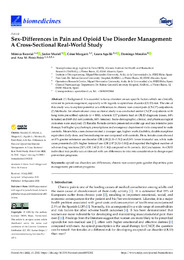Por favor, use este identificador para citar o enlazar este ítem:
https://hdl.handle.net/11000/31402Registro completo de metadatos
| Campo DC | Valor | Lengua/Idioma |
|---|---|---|
| dc.contributor.author | Escorial, Mónica | - |
| dc.contributor.author | Muriel, Javier | - |
| dc.contributor.author | César, Margarit | - |
| dc.contributor.author | Laura, Agulló | - |
| dc.contributor.author | Domingo, Morales | - |
| dc.contributor.author | Peiró Peiró, Ana M. | - |
| dc.contributor.other | Departamentos de la UMH::Medicina Clínica | es_ES |
| dc.date.accessioned | 2024-02-09T16:33:32Z | - |
| dc.date.available | 2024-02-09T16:33:32Z | - |
| dc.date.created | 2022 | - |
| dc.identifier.citation | Biomedicines . 2022 Sep 16;10(9):2302 | es_ES |
| dc.identifier.issn | 2227-9059 | - |
| dc.identifier.uri | https://hdl.handle.net/11000/31402 | - |
| dc.description.abstract | Background: It is essential to focus attention on sex-specific factors which are clinically relevant in pain management, especially with regards to opioid use disorder (OUD) risk. The aim of this study was to explore potential sex-differences in chronic non-cancer pain (CNCP) outpatients. (2) Methods: An observational cross-sectional study was conducted under CNCP outpatients with long-term prescribed opioids (n = 806), wherein 137 patients had an OUD diagnosis (cases, 64% females) and 669 did not (controls, 66% females). Socio-demographic, clinical, and pharmacological outcomes were analyzed. (3) Results: Female controls presented an older age and less intensive pain therapy but higher psychotropic prescriptions and emergency department visits compared to male controls. Meanwhile, cases demonstrated a younger age, higher work disability, double morphine equivalent daily dose, and benzodiazepine use compared with controls. Here, female cases showed an 8% greater substance use disorder (OR 2.04 [1.11-3.76]) and 24% lower tramadol use, while male cases presented a 22% higher fentanyl use (OR 2.97 [1.52-5.81]) and reported the highest number of adverse drug reactions (24%, OR 2.40 [1.12-5.16]) compared with controls. (4) Conclusions: An OUD individual risk profile was evidenced with sex-differences to take into consideration to design equal prevention programs. | es_ES |
| dc.format | application/pdf | es_ES |
| dc.format.extent | 11 | es_ES |
| dc.language.iso | eng | es_ES |
| dc.publisher | MDPI | es_ES |
| dc.rights | info:eu-repo/semantics/openAccess | es_ES |
| dc.rights | Attribution-NonCommercial-NoDerivatives 4.0 Internacional | * |
| dc.rights.uri | http://creativecommons.org/licenses/by-nc-nd/4.0/ | * |
| dc.subject | opioid use disorder | es_ES |
| dc.subject | sex-differences | es_ES |
| dc.subject | chronic non-cancer pain; | es_ES |
| dc.subject | gender disparities | es_ES |
| dc.subject | pain management | es_ES |
| dc.subject | prevention programs | es_ES |
| dc.title | Sex-Differences in Pain and Opioid Use Disorder Management: A Cross-Sectional Real-World Study | es_ES |
| dc.type | info:eu-repo/semantics/article | es_ES |
| dc.contributor.institute | Institutos de la UMH::Instituto de Bioingeniería | es_ES |
| dc.relation.publisherversion | https://doi.org/10.3390/biomedicines10092302 | es_ES |

Ver/Abrir:
Sex-Differences in Pain and Opioid Use Disorder Management.pdf
829,64 kB
Adobe PDF
Compartir:
 La licencia se describe como: Atribución-NonComercial-NoDerivada 4.0 Internacional.
La licencia se describe como: Atribución-NonComercial-NoDerivada 4.0 Internacional.
.png)